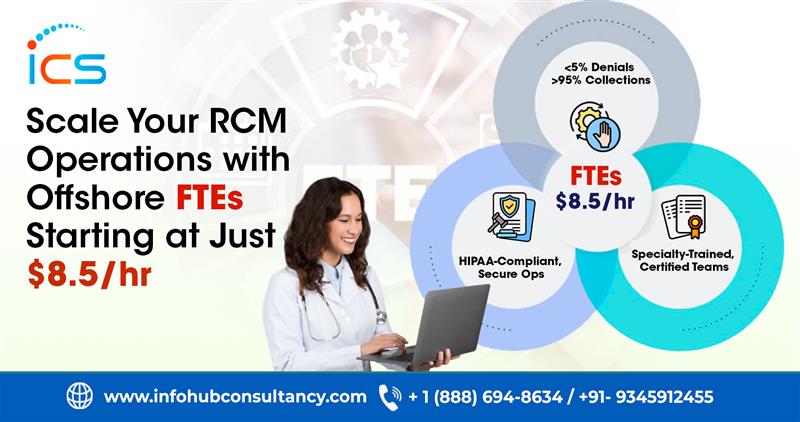Medical billing is a crucial task in healthcare organizations to make sure physicians receive payment for the services rendered. While medical billing requires a high level of accuracy and attention to detail, healthcare organizations often resort to various methods to manage their billing process. In-house or outsourced medical billing—both have their own perks. No matter which method you employ, the one thing it should assist in is increasing profits by reducing the denial rate. In outsourced medical billing, one option is the FTE pricing model, which involves hiring full-time employees to manage medical billing processes.
Let’s take a look at the pros and cons of the FTE model for medical billing.
Pros of the FTE model for medical billing:
1. Control and Authority:
One of the prime advantages of the FTE model is that healthcare organizations can do the staffing, training, and management of their own billing system. The healthcare organization has complete control over their medical billing process, which helps in the overall working of the organization as they can tailor their requirements based on their preferences and priorities. It is also beneficial in minimizing errors that occur during the complete billing process and creating a scope for growth for the organization.
2. Cost-effectiveness:
A high volume of medical billing can result in cost-effectiveness for healthcare organizations by hiring full-time employees. Outsourcing of medical billing services can be avoided by organizations by hiring an in-house medical billing team. Healthcare organizations can avoid paying for the training and overhead costs associated with outsourced billing services. In some cases, the cost savings associated with the FTE model can be significant.
3. Elasticity:
The adjustment in staffing levels based on the needs and requirements of the organization can be easily met according to the organization’s requirements. The organization can hire and train a new medical billing team to ensure compliance management. This allows FTE model in healthcare organizations to have greater flexibility in their medical billing processes.
4. Better Communication and Accountability:
Better communication is possible with the incorporation of the FTE model. There are teams assigned to do dedicated work, and they are responsible for that work. This provides smooth communication among the members of the teams from various departments within the organization. Hence, with an improved billing system, less or no claim denials are achieved with good team collaboration.
5. Quick and Easy Access:
You can enjoy the perks of quick access and the close proximity of the in-house billing department, which is a major advantage at the time of issues faced.
6. Digital Accounting Record:
EFT promotes an easy digital or electronic payment method and eliminates the paper payment method. This becomes helpful for easy tracking and linking of the payment. It is also beneficial to track and understand the client history for payments and services provided.
Cons of the FTE model for medical billing:
1. Staffing Challenges:
One of the primary challenges of the FTE model is staffing. Healthcare organizations must hire and train their own billing staff, which can be time-consuming and costly. Additionally, if an FTE employee leaves, the organization must go through the process of recruiting and hiring a replacement. This can be a significant disruption to the billing process and can result in delays in processing claims.
2. Lack of Specialization:
The FTE model may not provide healthcare organizations with access to specialized medical billing expertise. In contrast, outsourcing medical billing services can provide organizations with access to experts who are knowledgeable about the latest billing regulations and coding requirements. Specialized billing expertise is especially important for healthcare organizations that provide services in specialized areas such as oncology or pediatrics.
3. Technology Costs:
Healthcare organizations must purchase and maintain their own medical billing software, which can be expensive. Additionally, they must stay up-to-date with the latest technology, which can be a significant ongoing expense. Technology costs can be especially high for small to medium-sized organizations that do not have the resources to invest in the latest technology.
4. Limited Scalability:
Frequent fluctuations in the billing volume may lead to an unscalable FTE model for the healthcare organization. There can be insufficient staffing issues in an organization that experiences sudden growth or changes using the FTE model, which can result in delays in processing claims and increased billing errors.
5. Lesser Collections:
In-house billing processes have a comparatively lower net collection than that of the outsourced billing model.
6. Unexpected Stoppage:
Billing operations and cash flow may get affected or halt even if one billing member is absent, absconds, or quits work altogether.
7. Claim Denials:
Poor planning of the EFT model may lead to medical claim denials due to coding errors, expired time limits, overlapping claims, and non-covered charges.
Conclusion:
The FTE model has both pros and cons for healthcare organizations when it comes to medical billing. While it provides organizations with greater control and cost savings, it can also affect the organization with technology and staffing challenges in the absence of proper planning and execution. When you choose to partner with Info Hub Consultancy Services, a Leading medical billing company in India, you are sure to save time and a lot of other overhead costs while increasing profits. Contact us today to learn more and take the first step towards optimized medical billing.

 5 mins read
5 mins read 







.png)

